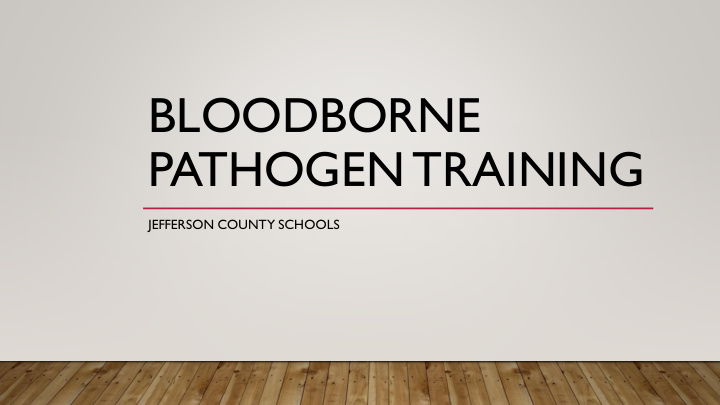



BLOODBORNE PATHOGEN TRAINING JEFFERSON COUNTY SCHOOLS
WHY BBP TRAINING? • T o protect our most valuable • Annual training is required asset – YOU! by OSHA • Reference: OSHA Title 29 Code of Federal Regulation at 29 CFT 1910.1930
WHAT ARE BBPS? • BBPs are disease causing organisms found in blood and certain body fluids of an infected person. BBPs may not cause symptoms for years, therefore people can spread the virus without knowing they are infected. You can't tell if someone is infected just by looking at them.
UNIVERSAL PRECAUTIONS Standard universal precautions require you to consider every person as a possible carrier of a BBP and to treat his/her blood and body fluids as if infected.
THREE MOST COMMON BLOODBORNE PATHOGENS HUMAN HEPATITIS B VIRUS IMMUNODEFICIENCY (HBV) VIRUS (HIV) HEPATITIS CVIRUS (HCV)
1 2 3 HUMAN IMMUNODEFICIENCY Attacks the May go No vaccine VIRUS (HIV) immune undetected and no cure system for years
1 2 3 HEPATITIS B VIRUS (HBV) Causes Can survive Vaccine is available inflammation of outside the body the liver; usually for a week or short-term more
1 2 3 HEPATITIS CVIRUS (HCV) Most common chronic Can result in serious Signs & symptoms may bloodborne infection long-term health include: in the US problems such as jaundice, fatigue, loss of cirrhosis,liver appetite, nausea and failure, and death abdominal pain
PROTECT YOURSELF Use Gloves Always use disposable vinyl gloves when dealing with anyone's blood Cover Cuts Cover any cuts or broken skin on your hands with bandages before putting on gloves Never Reuse Never reuse disposable vinyl gloves. Use a Mask Use a pocket mask or respirator if you need to give mouth-to-mouth resucitation. Remove and Replace If your gloves or other protective equipment are penetrated by blood, remove and replace immediately.
▪ Always wear gloves to protect your hands from contact with blood or body fluid. ▪ If there is a large amount of blood or body fluid, wear protective clothing, such as CLEANING UP a smock or gown. BLOOD AND ▪ Use disposable materials, such as paper towels, BODY FLUID to absorb blood. SPILLS ▪ Never use your hands to clean up contaminated objects. ▪ Dispose of all materials according to school policy.
HOW TO REMOVE USED GLOVES
HOW TO REMOVE USED GLOVES (CONTINUED)
• Dispose of used gloves promptly and properly. • NEVER touch the outside of a glove with your bare REMOVE skin. It is very important to prevent accidental GLOVES SAFELY exposure while removing gloves. TO PREVENT • After removing the gloves, wash your hands with non- ACCIDENTAL abrasive soap and water as soon as possible. The use of an alcohol-based hand sanitizer is acceptable. EXPOSURE
DISPOSING OF GARBAGE • Using gloves, dispose of cleaning materials and any protective clothing promptly and place in garbage. • Using proper technique, remove and dispose of gloves last. • Always pick up and carry garbage bags by the top. Never place a hand underneath or hold them against your body. Sharp objects can penetrate bags causing injury and possible exposure.
IF YOU THINK YOU'VE BEEN EXPOSED TO HIV, HBV OR HCV DO NOT PANIC! Exposure does not automatically mean that you are infected. Most exposures do not DO NOT PANIC result in disease. ACT QUICKLY! Wash the exposed area as soon as possible with NON-ABRASIVE soap. If blood or body ACT QUICKLY fluid enters your eyes, nose or mouth,flush the area with running water as soon as possible. FOLLOW UP FOLLOW UP! Exposure requires medical follow up as soon as possible.
Recommend
More recommend